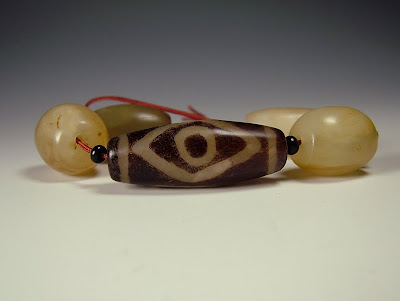Thursday, October 22, 2009
Wednesday, October 21, 2009
These distinct long agate beads (largest is 86 mm x 8 mm) are believed to come from South East Asia and are often identified as being 1000 years old or more (more evidence is needed to prove this). The material was carefully selected to showcase the natural crystalline stripe in the centre of each bead. Many examples have gold end caps. They have wonderful reddish hues when held to the light.
Wednesday, October 07, 2009
A Chinese imitation dZi bead (center). These beads appear to be made from bowenite which is a variety of the serpentine group. There are faint traces of eye decoration on the two beads that immediately flank the eye bead. This decoration has faded or rubbed off over time. They are probably 19th century creations. The darker eye bead is likely to be a later 20th century bead (1970s). They were collected in Nepal and Tibet. The central eye bead measures 36.46 mm x 13.67 mm
Sunday, October 04, 2009
In the past few years a number of ancient dZi beads are being seen in the marketplace with a new type of repair. Sometimes it is the restoration of only a small fragment or chip, however, this large two eyed bead has had both ends replaced with polymer (Keats, pers. com.). The work is often so good that it is hard to notice with the naked eye but under closer scrutiny it is much more obvious.
If purchasing an ancient bead one should check the bead very carfeully for damage. A very light tapping of the bead on your teeth is a good way to detect stone from the polymer areas. Using a UV light or taking a macro photograph should also show up any differences between the repair and the original stone. The above bead was repaired in Tibet but this method is also being used in Nepal. According to Dr James Keats, this is probably a polymer used widely by the dental profession and has been available for the last 10 years.
If purchasing an ancient bead one should check the bead very carfeully for damage. A very light tapping of the bead on your teeth is a good way to detect stone from the polymer areas. Using a UV light or taking a macro photograph should also show up any differences between the repair and the original stone. The above bead was repaired in Tibet but this method is also being used in Nepal. According to Dr James Keats, this is probably a polymer used widely by the dental profession and has been available for the last 10 years.
Saturday, October 03, 2009
Subscribe to:
Posts (Atom)







